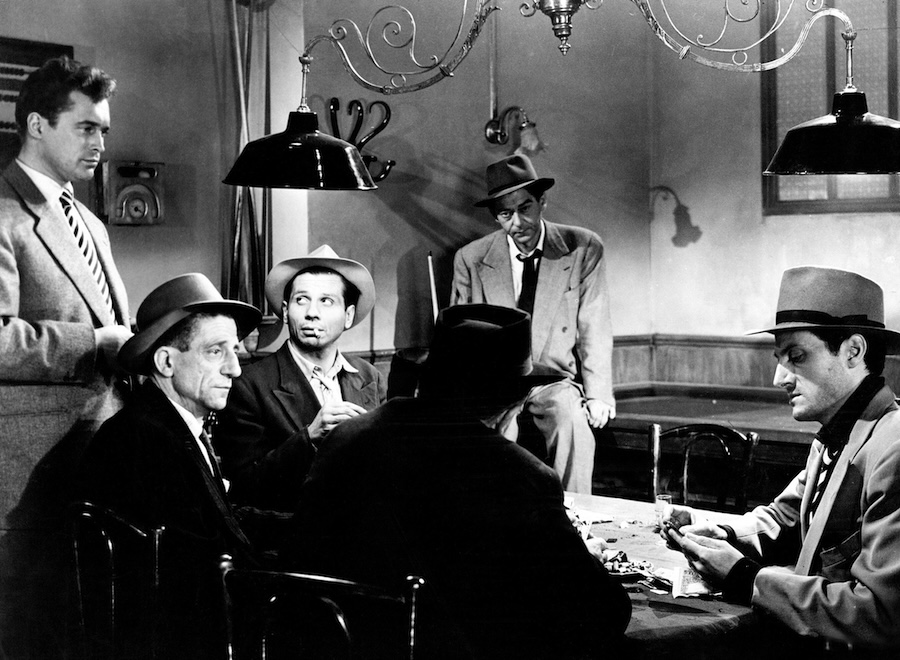
RIFIFI MEANS TROUBLE!

Jean-Luc Godard didn’t think too highly of Rififi. He knew it was a big hit and very influential, but considered certain later films much better, including Bob Le Flambeur (1956). Now that was an example of a great French crime film, in his mind. There’s no doubt however that Rififi is a more prominent classic. It’s hard to beat a movie that presented its central heist in such a detailed, convincing way that it inspired real-life crimes, and whose title now is used as a term for spectacular heists.
Getting out of prison
It’s winter in Paris and Tony (Jean Servais), who goes by the name ”Le Stéphanois”, has been released after a five-year stint in prison. He’s older now and not terribly interested in getting involved when his friend Mario (Robert Manuel) suggests a slightly more sophisticated version of a smash-and-grab hit on a nearby jeweler. After meeting his former girlfriend Mado (Marie Sabouret) and learning that she’s dating the brutal gangster Pierre Grutter (Marcel Lupovici), Tony has a change of heart and goes back to Mario, telling him that he prefers to rob the safe inside the store. However, it’s a very difficult job that requires a skilled safecracker and a fool-proof plan for the burglary.
A dialogue- and music-free half hour
The most famous sequence in the film has gone down in cinema history, a dialogue- and music-free half hour where Tony and his gang break into the store from the apartment above, successfully disable the alarm system after having spent a lot of time figuring out various ways to do it, and then start working that safe, a sweaty challenge that takes hours as night becomes early morning and the risk of getting caught increases. It’s not much of a spoiler to say that they finally get their hands on the fortune inside; the film is far from over at that point.
What begins as a fairly entertaining depiction of the criminals preparing for the heist becomes a nail-biter that keeps up tension, as Grutter and his gang realize who’s behind the crime and do whatever it takes to steal the loot. The heist was in fact inspired by a real-life crime, which took place in Marseille in 1899, and due to the brilliantly meticulous work by Jules Dassin and his crew in constructing the heist, Rififi was criticized, even banned in some countries, for providing a manual to burglary.
Jules Dassin recognized what was worth exploring in Auguste Le Breton’s novel and made sure everything else was ignored.
The movie was also controversial because of Dassin. The director had been named as a Communist during the McCarthy hearings and left Hollywood for Europe. Rififi became a magnificent comeback, putting his talents on display for the world to see. It’s a good thing that Dassin was chosen to direct and co-write the script. He recognized what was worth exploring in Auguste Le Breton’s novel and made sure everything else was ignored.
It’s been said that one scene in particular, where Tony commits murder, should be interpreted as a comment on Dassin’s experiences during the McCarthy years. Is the film that personal? Who knows, it is for sure the result of professionals delivering, even on a small budget that required creative solutions, including Dassin casting himself as the safecracker. Much of it works perhaps thanks to the modest budget, such as the decision to film much of the action on the wet streets of Paris rather than using sets, and the hiring of Servais as the aging, no-nonsense gangster who agrees to one last job.
In a Chicago Reader review, Dave Kehr wrote that he found the final act ”moralistic”. I disagree, in my mind it is realistic and logical, a natural (and obviously thrilling) conclusion in the lives of these people.
Rififi 1955-France. 115 min. B/W. Directed by Jules Dassin. Screenplay: Jules Dassin, René Wheeler. Novel: Auguste Le Breton. Cinematography: Philippe Agostini. Music: Georges Auric. Cast: Jean Servais (Tony/Le Stéphanois), Carl Möhner (Jo/Le Suédois), Robert Manuel (Mario Ferrati), Jules Dassin, Magali Noël, Claude Sylvain.
Trivia: Original title: Du rififi chez les hommes. Jean-Pierre Melville was first hired to direct. The film was followed by several other Le Breton adaptations with Rififi in the title.
Cannes: Best Director.
Last word: “We were very hesitant and fearful about using that title, but it worked. The word, particularly in Europe, has come into the language after the film. It’s adapted from tribes in North Africa called the “rifs’ that are pretty much in constant conflict; from that came the word invented by Mr. Le Breton. It means quarrels, scraps, conflicts.” (Dassin, Denver Post)
